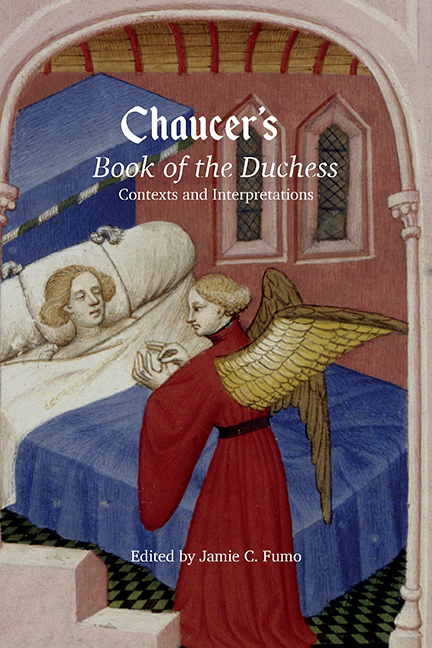Book contents
- Frontmatter
- Contents
- List of Illustrations
- Acknowledgments
- List of Contributors
- Abbreviations and Editions
- Introduction: Reopening the Book of the Duchess
- I Books and Bodies
- 1 Codicology, Text, and the Book of the Duchess
- 2 Idleness, Chess, and Tables: Recuperating Fables in Chaucer's Book of the Duchess
- 3 ‘Noon other werke’: The Work of Sleep in Chaucer's Book of the Duchess
- 4 Discovering Woe: The Translation of Affect in Chaucer's Book of the Duchess and Spenser's Daphnaïda
- II The Intertextual Duchess
- Bibliography
- Index
- Miscellaneous Endmatter
1 - Codicology, Text, and the Book of the Duchess
from I - Books and Bodies
Published online by Cambridge University Press: 18 April 2018
- Frontmatter
- Contents
- List of Illustrations
- Acknowledgments
- List of Contributors
- Abbreviations and Editions
- Introduction: Reopening the Book of the Duchess
- I Books and Bodies
- 1 Codicology, Text, and the Book of the Duchess
- 2 Idleness, Chess, and Tables: Recuperating Fables in Chaucer's Book of the Duchess
- 3 ‘Noon other werke’: The Work of Sleep in Chaucer's Book of the Duchess
- 4 Discovering Woe: The Translation of Affect in Chaucer's Book of the Duchess and Spenser's Daphnaïda
- II The Intertextual Duchess
- Bibliography
- Index
- Miscellaneous Endmatter
Summary
The range of questions posed by the codicological and textual forms in which The Book of the Duchess (hereafter BD) survives is closely connected to the larger enigma of the context in which it originated and was first recorded in manuscript. The three surviving copies all date from around 50 years or more after Chaucer's death, and they offer no explicit information about the historical circumstances in which the poem took shape and was first transmitted. There are no forms of external evidence concerning its date or occasion of composition, and much weight has had to be placed on cryptic internal allusions in order to reconstruct a plausible occasional significance: the death from plague of John of Gaunt's first wife, Blanche, duchess of Lancaster on 12 September 1368. The poem makes no explicit allusion to her death, and only the line ‘And goode faire White she het’ (948), and a cluster of final gestures (1318–19) to Lancaster (‘long castel’), ‘St John’, and ‘Richmond’ (‘ryche hil’: John of Gaunt was earl of Richmond in Yorkshire until 1372) suggest its connections with the death of the duchess.
This internal allusion to ‘White’ is supported by some very late evidence in one manuscript. Oxford, Bodleian Library MS Fairfax 16 includes at the beginning of the poem the added note that it was ‘made by Geffrey Chawcyer at ye request of ye duke of lancastar: pitously complaynynge the deathe of ye sayd dutchesse blanche’ (fol. 130). This note, in the hand of the sixteenth-century antiquary John Stow (1525–1605), provides the earliest surviving assertion of the poem's occasion. Stow has also written the name ‘blanche’ in the margins opposite several occurrences of the word ‘white’ in the poem, at lines 905 (fol. 141v) and 948 (fol. 142); his is probably also the hand that has written ‘she ys dedde’ (fol. 147) in the margin opposite line 1298 (‘Sir quod I where is she now’, anticipating line 1309: ‘She ys ded’). Stow was both a collector of Middle English manuscripts and an antiquarian of distinction who clearly had some interest in the content of the poem and in Chaucer more generally.
- Type
- Chapter
- Information
- Chaucer's Book of the Duchess , pp. 11 - 28Publisher: Boydell & BrewerPrint publication year: 2018
- 1
- Cited by

